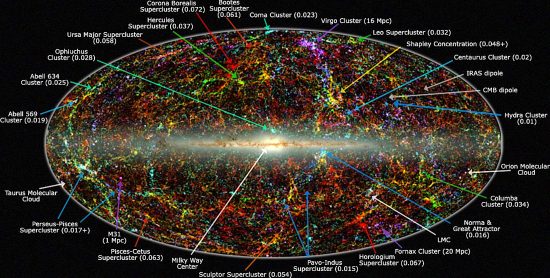
May 8, 2019
The Universe is not expanding.
“After a ridiculously long time it has finally dawned on me that establishment scientists actually proceed on the belief that theories tell you what is true and not true!”
— Halton Arp
Astronomers think that galactic recession is occurring, because galaxies received “inflationary energy” from the Big Bang explosion. The recession is thought to be about 71 kilometers per second for every 3.3 million light-years of spatial distance. This “dilation of space-time” is called the Hubble constant.
According to a recent press release, “Hubble’s measurements of today’s expansion rate do not match the rate that was expected based on how the Universe appeared shortly after the Big Bang over 13 billion years ago.”
In the 1960s, measurements of the Local Group, containing the Milky Way, revealed a 600 kilometer-per-second acceleration toward the constellation Centaurus over 150 million light-years away. The Local Group, along with the Virgo supercluster, the Hydra-Centaurus supercluster, and other galactic superclusters are thought to be drawn toward a deep space structure known as the Great Attractor. The Great Attractor is thought to be associated with a group of objects called the Centaurus Wall.
Conventional redshift measurements of galaxies in the Local Group also show them flying toward the center of the Virgo cluster at nearly two million kilometers per hour. The Virgo cluster is 50 million light years away and whatever is pulling on it also remains invisible. Astronomer Sherry Suyu wrote:
“The Hubble constant is crucial for modern astronomy as it can help to confirm or refute whether our picture of the universe — composed of dark energy, dark matter and normal matter — is actually correct, or if we are missing something fundamental.”
It is not the intent of this paper to address dark matter and dark energy, since those ideas are discussed in recent Picture of the Day articles. Suffice to say, the information contained in the Space Telescope press release relies on many assumptions. One assumption is that galaxy clusters are large and far away, so they are looking for some way to show how far. However, the late Halton Arp conducted research indicating that compact galactic clusters are small and faint and are ejected from nearby active galaxies. Like quasars, those clusters are often embedded in radio and X-ray-emitting lobes coming from the parent galaxy.
Astronomers assume that redshift is a Doppler effect, indicating velocity. Arp’s work revealed that galactic redshifts are mostly intrinsic, since galaxies with different redshifts are connected by bridges of luminous material. Redshifts, when adjusted to the parent galaxy’s reference frame, are periodic and occur only in preferred values.
In an Electric Universe, if galaxies within a cluster are oppositely charged from the cluster core, the core will pull them in toward the region of greatest charge density, so they will experience “anomalous velocity”. When there are regions of charge separation within a galaxy, then the material that is the same polarity as the cluster core will be blown back and away, like the coma and tail of a comet in the Solar System.
It is electricity that is missing in conventional explanations.
Stephen Smith












